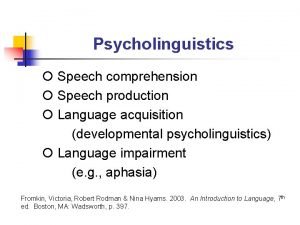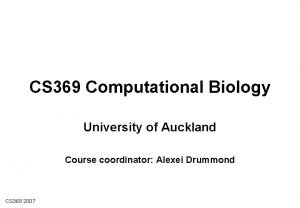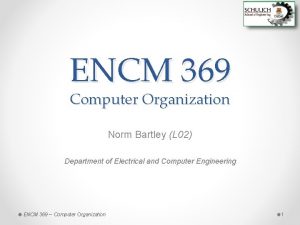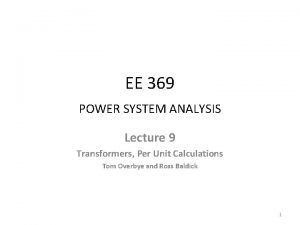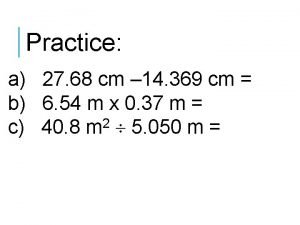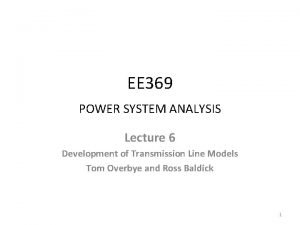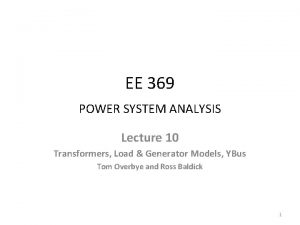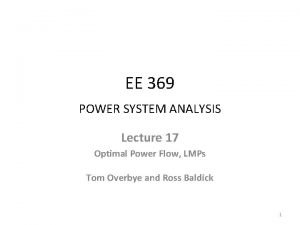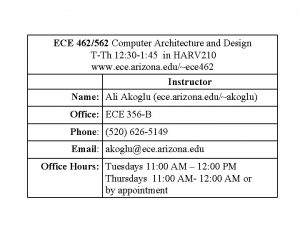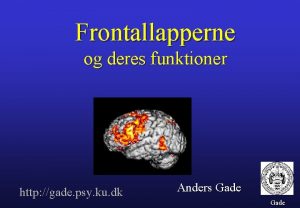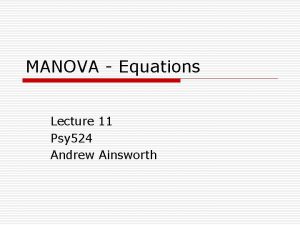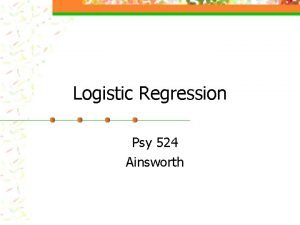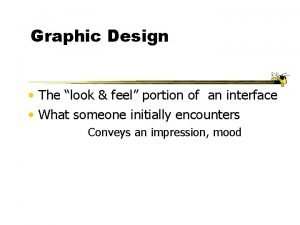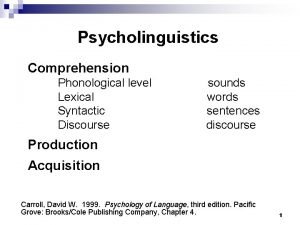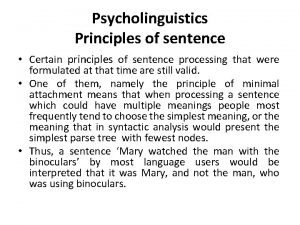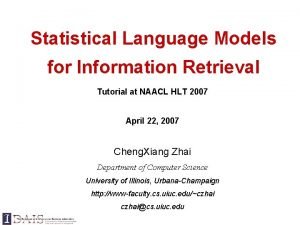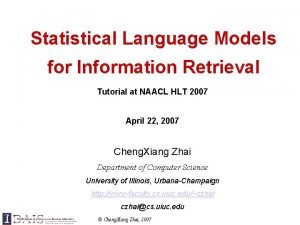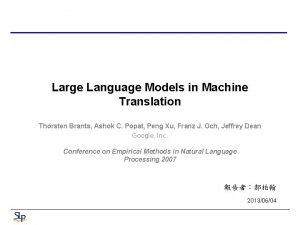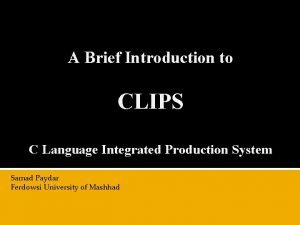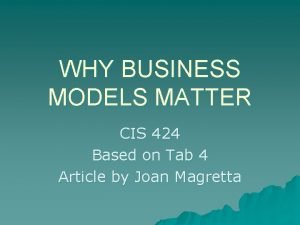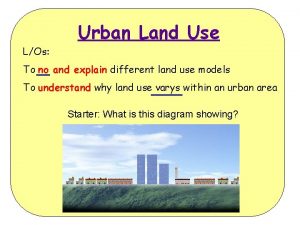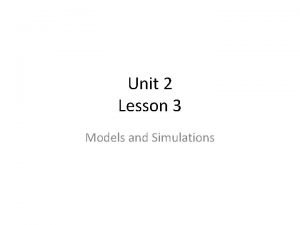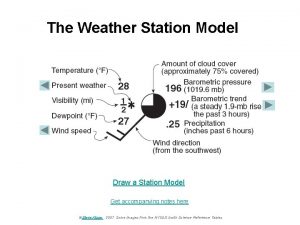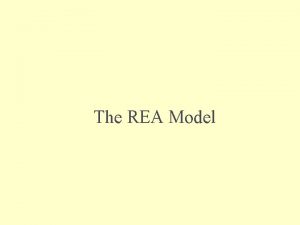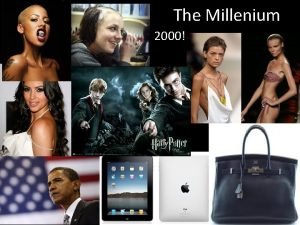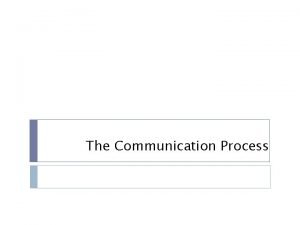PSY 369 Psycholinguistics Language Production Models of language








































































- Slides: 72

PSY 369: Psycholinguistics Language Production: Models of language production

Announcements n Exam 2 is coming up (Thurs, Apr. 1) n An updated review sheet is on the syllabus

Brief roadmap n Language production research n Today: n Models of Language production n n Levelt’s model Dell’s model Some of the characteristics that distinguish the models Some of the research to investigate the models Tuesday: Conversation – Production and Comprehension come together

Nitty-gritty details of the model Message level n A central question: n How do we do speak so quickly and fluently? n Syntactic level Morphemic level Phonemic level Articulation n Are the stages discrete or cascading? n Discrete (modular): must complete before moving on n Cascade: can get started as soon as some information is available Is there feedback? n Top-down only (serial processing) n Garrett, Levelt n Bottom up too (interactive processing) n Dell, Stemberger, Mc. Kay

Two different models Levelt (1989) Dell (1986) TACTIC FRAMES LEXICAL NETWORK

Levelt’s model n Four broad stages: n Conceptualization n n Formulation n n Turning the message into linguistic representations Grammatical encoding (finding words and putting them together) Phonological encoding (finding sounds and putting them together) Articulation n n Deciding on the message (= meaning to express) Speaking (or writing or signing) Monitoring (via the comprehension system)

Levelt’s model n Formalization on the Syntax side of the model n Works in parallel with the lexicon side Functional processing: Assignment of roles Grammatical subject Direct object

Levelt’s model n Formalization on the Syntax side of the model n Works in parallel with the lexicon side Positional processing: Build syntactic tree S VP NP V NP

Levelt’s model n Formalization on the Lexicon side of the model n Involves lexical retrieval: n n n Semantic/syntactic content (lemmas) Phonological content (lexemes or word-forms) Tip of tongue state when lemma is retrieved without word-form being retrieved

Levelt’s model (see chpt 5, pg 115 -117) has stripes is dangerous Lexical concepts TIGER (X) Noun tigre Fem. countable Lexemes /tigre/ /t/ /I/ Lemmas /g/ Phonemes

Levelt’s model: conceptual level has stripes is dangerous n TIGER (X) Noun tigre Fem. countable /tigre/ /t/ /I/ /g/ Conceptual level is not decomposed n one lexical concept node for “tiger” n instead, conceptual links from “tiger” to “stripes”, etc.

Levelt’s model: meaning & syntax n First, lemma activation occurs is dangerous has stripes n TIGER (X) n Noun tigre Fem. countable /tigre/ /t/ /I/ /g/ This involves activating a lemma or lemmas corresponding to the concept thus, concept TIGER activates lemma “tiger”

Levelt’s model: meaning & syntax n First, lemma activation occurs is dangerous has stripes This involves activating a lemma or lemmas corresponding to the concept n TIGER (X) LION (X) Noun tigre Fem. lion n n thus, concept TIGER activates lemma “tiger” But also involves activating other lemmas n /tigre/ /t/ /I/ n /g/ TIGER also activates LION (etc. ) to some extent and LION activates lemma “lion”

Levelt’s model: meaning & syntax has stripes n First, lemma activation occurs is dangerous n Second, lemma selection occurs n Selection is different from TIGER (X) LION (X) activation Noun n n tigre Fem. lion Only one lemma is selected Probability of selecting the target lemma (“tiger”) n /tigre/ /t/ /I/ n /g/ ratio of that lemma’s activation to the total activation of all lemmas (“tiger”, “lion”, etc. ) Hence competition between semantically related lemmas

Morpho-phonological encoding (and beyond) has stripes is dangerous The lemma is now converted into a phonological representation n TIGER (X) Noun n n countable If “tiger” lemma plus plural (and noun) are activated n tigre Fem. n /t/ /I/ /g/ Leads to activation of morphemes tigre and s Other processes too n /tigre/ called “word-form” (or “lexeme”) Stress, phonological segments, phonetics, and finally articulation

Model’s assumptions n Modularity n Later processes cannot affect earlier processes n n No feedback between the word-form (lexemes) layer and the grammatical (lemmas) layer Also, only one lemma activates a word form n n n If “tiger” and “lion” lemmas are activated, they compete to produce a winner at the lemma stratum Only the “winner” activates a word form (selection) The word-forms for the “losers” aren’t accessed

Dell’s interactive account n Dell (1986) presented the one of the best-known interactive accounts n n other similar accounts exist (e. g. , Stemberger, Mc. Kay) Network organization n 3 levels of representation n n Semantics (decomposed into features) Words and morphemes phonemes (sounds) These get selected and inserted into frames

Dell’s interactive account TACTIC FRAMES LEXICAL NETWORK Dell (1986) A moment in the production of: “Some swimmers sink”

Dell’s interactive account TACTIC FRAMES LEXICAL NETWORK Dell (1986) information n n Interactive because information flows “upwards” as well as “downwards” Cascading because processing at lower levels can start early

Dell’s interactive account Dell (1986) FURRY dot BARKS MAMMAL dog log n n n /t/ /d/ /g/ /a/ /l/ e. g. , the semantic features mammal, barks, four-legs activate the word “dog” this activates the sounds /d/, /o/, /g/ these send activation back to the word level, activating words containing these sounds (e. g. , “log”, “dot”) to some extent this activation is upwards (phonology to syntax) and wouldn’t occur in Levelt’s account

Model comparisons Similarities Similar representations Frames and slots Insertion of representations into the frames Levelt’s Differences Serial Modular External monitor (comprehension) Dell’s Interactive Cascaded

Testing Models of language production n Experimental investigations of some of these issues n Time course - cascading vs serial n n Separation of syntax and semantics n n Picture word interference Subject verb agreement Abstract syntax vs surface form n Syntactic priming

Experimental tests n Picture-word interference task n Task: n tiger n Participants name basic objects as quickly as possible Distractor words are embedded in the object (or presented aloud) n Participants are instructed to ignore these words

Experimental tests n Picture-word interference task n Semantic interference n tiger Meaning related words can slow down naming the picture n e. g. , the word TIGER in a picture of a LION

Experimental tests n Picture-word interference task n n liar Semantic interference Form-related words can speed up processing n e. g. , the word liar in a picture of a LION

Experimental tests liar time n Experiments manipulate timing: n n n picture and word can be presented simultaneously or one can slightly precede the other We draw inferences about time-course of processing

Evidence against interactivity n Schriefers, Meyer, and Levelt (1990) n n DOT phonologically related CAT semantically related SHIP unrelated word SOA (Stimulus onset asynchrony) manipulation n -150 ms (word … 150 ms … picture) 0 ms (i. e. , synchronous presentation) +150 ms (picture … 150 ms …word)

Evidence against interactivity n Schriefers, Meyer, and Levelt (1990) n n n Early Only Semantic effects DOT phonologically related CAT semantically related SHIP unrelated word Late Only Phonological effects

Evidence against interactivity Schriefers, Meyer, and Levelt (1990) n Also looked for any evidence of a mediated priming effect hat n DOG (X) CAT (X) dog cat /cat/ Found no evidence for it /k/ /a/ /hat/ /h/

Interpretation n n Early semantic inhibition Late phonological facilitation Fits with the assumption that semantic processing precedes phonological processing No overlap n n suggests two discrete stages in production an interactive account might find semantic and phonological effects at the same time

Evidence for interactivity n Mixed errors n n Both semantic and phonological relationship to target word Target = “cat” n n semantic error = “dog” phonological error = “hat” mixed error = “rat” Occur more often than predicted by modular models n if you can go wrong at either stage, it would only be by chance that an error would be mixed

Evidence for interactivity n Dell’s explanation n The process of making an error n n n The semantic features of dog activate “cat” Some features (e. g. , animate, mammalian) activate “rat” as well “cat” then activates the sounds /k/, /ae/, /t/ /ae/ and /t/ activate “rat” by feedback This confluence of activation leads to increased tendency for “rat” to be uttered Also explains the tendency for phonological errors to be real words (lexical bias effect) n Sounds can only feed back to words (non-words not represented) so only words can feedback to sound level

Evidence for interactivity n A number of recent experimental findings appear to support interaction under some circumstances (or at least cascading models) n n n Damian & Martin (1999) Cutting & Ferreira (1999) Peterson & Savoy (1998)

Evidence for interactivity n n n peach Damian and Martin (1999) Picture-Word interference The critical difference: n n the addition of a “semantic and phonological” condition Picture of Apple n n peach (semantically related) apathy (phonologically related) apricot (sem & phono related) couch (unrelated)

Evidence for interactivity n Damian & Martin (1999) couch (unrelated) peach (semantically related) apathy (phonologically related) apricot (sem & phono related) n early semantic inhibition

Evidence for interactivity n Damian & Martin (1999) couch (unrelated) peach (semantically related) apathy (phonologically related) apricot (sem & phono related) n n early semantic inhibition late phonological facilitation (0 and + 150 ms)

Evidence for interactivity n Damian & Martin (1999) couch (unrelated) peach (semantically related) apathy (phonologically related) apricot (sem & phono related) n n early semantic inhibition late phonological facilitation (0 and + 150 ms) n Shows overlap, unlike Schriefers et al.

Evidence for interactivity n n n Cutting and Ferreira (1999) Picture-Word interference The critical difference: n dance n Used homophone pictures Related distractors could be to the depicted meaning or alternative meaning “game” “dance” “hammer” (unrelated) n Only tested -150 SOA

Evidence for interactivity n Cutting and Ferreira (1999) GAME (X) BALL (X) DANCE (X) game ball dance /ball/ Cascading Prediction: dance ball /ball/

Evidence for interactivity n Cutting and Ferreira (1999) n Early semantic inhibition

Evidence for interactivity n Cutting and Ferreira (1999) n n n Early semantic inhibition Early Facilitation from a phonologically mediated distractor Evidence of cascading information flow (both semantic and phonological information at early SOA)

Evidence for interactivity Peterson & Savoy (1998) n Slightly different task ? n n Prepare to name the picture If “? ” comes up name it

Evidence for interactivity Peterson & Savoy (1998) n Slightly different task n liar n n n Prepare to name the picture If “? ” comes up name it If a word comes up instead, name the word Manipulate n n Word/picture relationship SOA

Evidence for interactivity Peterson & Savoy (1998) n Used pictures with two synonymous names soda Subordinate Dominant sofa couch n Used words that were phonologically related to the non dominant name of the picture

Evidence for interactivity n Peterson & Savoy n Found evidence for phonological activation of near synonyms: n n Participants slower to say distractor soda than unrelated distractor when naming couch n Soda is related to non-selected sofa Remember that Levelt et al. assume that only one lemma can be selected and hence activate a phonological form n Levelt et al’s explanation: Could be erroneous selection of two lemmas?

Can the two-stage account be saved? n Evidence for interaction is hard to reconcile with the Levelt account n However, most attempts are likely to revolve around the monitor n n Basically, people sometimes notice a problem and screen it out Levelt argues that evidence for interaction really involves “special cases”, not directly related to normal processing

Overall summary n Levelt et al. ’s theory of word production: n n n Dell’s interactive account: n n Strictly modular lexical access Syntactic processing precedes phonological processing Interaction between syntactic and phonological processing Experimental evidence is equivocal, but increasing evidence that more than one lemma may activate associated word-form

Conversational interaction “the horse raced past the barn” “the kids swam across the river” Conversation is more than just two side-byside monologues.

Conversational interaction “The horse raced past the barn” “Really? Why would it do that? ” Conversation is a specialized form of social interaction, with rules and organization.

Conversation n Herb Clark (1996) n Joint action n People acting in coordination with one another n n n Autonomous actions n n doing the tango driving a car with a pedestrian crossing the street n The participants don’t always do similar things Things that you do by yourself Participatory actions n Individual acts only done as parts of joint actions

Conversation n Herb Clark (1996) n Speaking and listening n Traditionally treated as autonomous actions n n Contributing to the tradition of studying language comprehension and production separately Clark proposed that they should be treated as participatory actions

Conversation n Herb Clark (1996) n Speaking and listening n Component actions in production and comprehension come in pairs Speaking Listening n A vocalizes sounds for B n B attends to A’s vocalizations n A formalizes utterances for B n B identifies A’s utterances n A means something for B n B understands A’s meaning n The actions of one participant depend on the actions of the other

Conversation n Herb Clark (1996) n Face-to-face conversation - the basic setting n Features Immediacy n Co-presence Visibility Audibility n Instantaneity n n n Medium n n n Evanescence Recordlessness Simultaneity Control n n n Extemporaneity Self-determination Self-expression Other settings may lack some of these features n e. g. , telephone conversations take away co-presence and visibility, which may change language use

Meaning and understanding n n n n n ABBOTT: Super Duper computer store. Can I help you? COSTELLO: Thanks. I'm setting up an office in my den, and I'm thinking about buying a computer. ABBOTT: Mac? COSTELLO: No, the name is Lou. ABBOTT: Your computer? COSTELLO: I don't own a computer. I want to buy one. ABBOTT: Mac? COSTELLO: I told you, my name is Lou. ABBOTT: What about Windows? COSTELLO: Why? Will it get stuffy in here? ABBOTT: Do you want a computer with windows? COSTELLO: I don't know. What will I see when I look in the windows? ABBOTT: Wallpaper. COSTELLO: Never mind the windows. I need a computer and software. ABBOTT: Software for windows? COSTELLO: No. On the computer! I need something I can use to write proposals, track expenses and run my business. What have you got? ABBOTT: Office.

Meaning and understanding n n n n n COSTELLO: Yeah, for my office. Can you recommend anything? ABBOTT: I just did. COSTELLO: You just did what? ABBOTT: Recommend something. COSTELLO: You recommended something? ABBOTT: Yes. COSTELLO: For my office? ABBOTT: Yes. COSTELLO: OK, what did you recommend for my office? ABBOTT: Office. COSTELLO: Yes, for my office! ABBOTT: I recommend office with windows. COSTELLO: I already have an office and it has windows!OK, lets just say, I'm sitting at my computer and I want to type a proposal. What do I need? ABBOTT: Word. COSTELLO: What word? ABBOTT: Word in Office. COSTELLO: The only word in office is office. ABBOTT: The Word in Office for Windows.

Meaning and understanding n n n n n COSTELLO: Which word in office for windows? ABBOTT: The Word you get when you click the blue "W. ” COSTELLO: I'm going to click your blue "w" if you don't start with some straight answers. OK, forget that. Can I watch movies on the Internet? ABBOTT: Yes, you want Real One. COSTELLO: Maybe a real one, maybe a cartoon. What I watch is none of your business. Just tell me what I need! ABBOTT: Real One. COSTELLO: If itユs a long movie I also want to see reel 2, 3 and 4. Can I watch them? ABBOTT: Of course. COSTELLO: Great, with what? ABBOTT: Real One. COSTELLO; OK, I'm at my computer and I want to watch a movie. What do I do? ABBOTT: You click the blue "1. ” COSTELLO: I click the blue one what? ABBOTT: The blue "1. ” COSTELLO: Is that different from the blue "W"? ABBOTT: The blue 1 is Real One and the blue W is Word. COSTELLO: What word?

Meaning and understanding n n n n ABBOTT: The Word in Office for Windows. COSTELLO: But there are three words in "office for windows"! ABBOTT: No, just one. But itユs the most popular Word in the world. COSTELLO: It is? ABBOTT: Yes, but to be fair, there aren't many other Words left. It pretty much wiped out all the other Words. COSTELLO: And that word is real one? ABBOTT: Real One has nothing to do with Word. Real One isn't even Part of Office. COSTELLO: Stop! Don't start that again. What about financial bookkeeping you have anything I can track my money with? ABBOTT: Money. COSTELLO: That's right. What do you have? ABBOTT: Money. COSTELLO: I need money to track my money? ABBOTT: It comes bundled with your computer. COSTELLO: What's bundled to my computer? ABBOTT: Money.

Meaning and understanding n n n COSTELLO: Money comes with my computer? ABBOTT: Yes. No extra charge. COSTELLO: I get a bundle of money with my computer? How much? ABBOTT: One copy. COSTELLO: Isn't it illegal to copy money? ABBOTT: Microsoft gave us a license to copy money. COSTELLO: They can give you a license to copy money? ABBOTT: Why not? THEY OWN IT! (LATER) COSTELLO: How do I turn my computer off? ? ABBOTT: Click on "START".

Meaning and understanding n Common ground n Knowledge, beliefs and suppositions that the participants believe that they share n n Members of cultural communities Shared experiences What has taken place already in the conversation Common ground is necessary to coordinate speaker’s meaning with listener’s understanding

Structure of a conversation n Conversations are purposive and unplanned n n n Typically you can’t plan exactly what you’re going to say because it depends on another participant Conversations look planned only in retrospect Conversations have a fairly stable structure

Structure of a conversation n n n n Joe: (places a phone call) Kevin: Miss Pink’s office - hello Joe: hello, is Miss Pink in Kevin: well, she’s in, but she’s engaged at the moment, who is it? Joe: Oh it’s Professors Worth’s secretary, from Pan-American college Kevin: m, Joe: Could you give her a message “for me” Kevin: “certainly” Joe: u’m Professor Worth said that, if Miss Pink runs into difficulties, . . On Monday afternoon, . . With the standing subcommittee, . . Over the item on Miss Panoff, … n n n n n Kevin: Miss Panoff? Joe: Yes, that Professor Worth would be with Mr Miles all afternoon, . . So she only had to go round and collect him if she needed him, … Kevin: ah, … thank you very much indeed, Joe: right Kevin: Panoff, right “you” are Joe: right Kevin: I’ll tell her, Joe: thank you Kevin: bye Joe: bye

Structure of a conversation n Action sequences: smaller joint projects to fulfill a goal n Adjacency pairs n Opening the conversation n Kevin: Miss Pink’s office - hello Joe: hello, . . Exchanging information about Pink n n Joe: . . , is Miss Pink in Kevin: well, she’s in, but she’s engaged at the moment…

Structure of a conversation n Action sequences: smaller joint projects to fulfill a goal n Adjacency pairs n Exchanging the message from Worth n n Joe: u’m Professor Worth said that, if Miss Pink runs into difficulties, . . On Monday afternoon, . . With the standing subcommittee, . . Over the item on Miss Panoff, … Closing the conversation n n Kevin: I’ll tell her, Joe: thank you Kevin: bye Joe: bye

Opening conversations n Need to pick who starts n n Turn taking is typically not decided upon in advance Potentially a lot of ways to open, but we typically restrict our openings to a few ways n n Address another Request information Offer information Use a stereotyped expression or topic

Opening conversations n Has to resolve: n The entry time n n The participants n n Who is talking to whom? Their roles n n Is now the time to converse? What is level of participation in the conversation? The official business n What is the conversation about?

Identifying participants n Conversation often takes place in situations that involve various types of participants and non-participants Speaker All participants All listeners Addressee Side participants Bystander Eavesdropper

Taking turns n Typically conversations don’t involve two (or more) people talking at the same time n n n Individual styles of turn-taking vary widely Length of a turn is a fairly stable characteristic within a given individual’s conversational interactions Standard signals indicate a change in turn: a head nod, a glance, a questioning tone

Taking turns n Typically conversations don’t involve two (or more) people talking at the same time n Three implicit rules (Sacks et al, 1974) n n Rule 1: Current speakers selects next speaker Rule 2: Self-selection: if rule 1 isn’t used, then next speaker can select themselves Rule 3: current speaker may continue (or not) These principles are ordered in terms of priority n The first is the most important, and the last is the least important n Just try violating them in an actual conversation (but debrief later!)

Taking turns n Typically conversations don’t involve two (or more) people talking at the same time n Use of non-verbal cues n n n Drop of pitch Drawl on final syllable Termination of hand signals Drop in loudness Completion of a grammatical clause Use of stereotyped phrase n “you know”

Negotiating topics n Keep the discourse relevant to the topic (remember Grice’s maxims) n Coherence again n n Earlier we looked at coherence within a speaker, now we consider it across multiple speakers Must use statements to signal topic shifts

Closing conversations n Closing statements n Must exit from the last topic, mutually agree to close the conversation, and coordinate the disengagement n signal the end of conversation (or topic) n n Justifying why conversation should end n n “okay” “I gotta go” Reference to potential future conversation n “later dude”

Summary n “People use language for doing things with each other, and their use of language is itself a joint action. ” Clark (1996, pg 387) n Conversation is structured n n But, that structure depends on more than one individual Models of language use (production and comprehension) need to be developed within this perspective
 Yang merupakan pengertian production adalah
Yang merupakan pengertian production adalah Language loss in psycholinguistics
Language loss in psycholinguistics Language comprehension in psycholinguistics
Language comprehension in psycholinguistics Cratily
Cratily Short division vs long division
Short division vs long division Cs 369
Cs 369 369
369 Ge power management
Ge power management Encm 369
Encm 369 369 meaning
369 meaning 369 power
369 power Bio 369
Bio 369 369 project
369 project 369 project
369 project 369 power
369 power Datapy.bar
Datapy.bar 369 power
369 power Ece 369
Ece 369 Euro psy
Euro psy Psb ucf
Psb ucf Psy2055
Psy2055 Psy 2055
Psy 2055 Xxxxblue
Xxxxblue Psy
Psy Daniel sanin
Daniel sanin Psy
Psy Psy 421
Psy 421 Psy
Psy Psy
Psy Psy 226
Psy 226 Maria took a drink from a container marked milk
Maria took a drink from a container marked milk Psy academy
Psy academy Psy ku
Psy ku Psy walsh
Psy walsh Veľký bradáč charakteristika
Veľký bradáč charakteristika Gramaticke kategorie
Gramaticke kategorie 11 psy
11 psy Regression psy
Regression psy Psy
Psy What is adoloscence
What is adoloscence What is the difference between models and semi modal
What is the difference between models and semi modal What is psycholinguistics
What is psycholinguistics Scope of psycholinguistics
Scope of psycholinguistics History of psycholinguistics
History of psycholinguistics Example of psycholinguistics
Example of psycholinguistics Psycholinguistics
Psycholinguistics Psycholinguistics
Psycholinguistics Interlanguage slideshare
Interlanguage slideshare Spreading activation psychology
Spreading activation psychology Psycholinguistic aspects of interlanguage
Psycholinguistic aspects of interlanguage Psycholinguistic aspects of interlanguage
Psycholinguistic aspects of interlanguage Comprehension of words in psycholinguistics
Comprehension of words in psycholinguistics Language a
Language a Psycholinguistics psychology definition
Psycholinguistics psychology definition What is the scope of psycholinguistics
What is the scope of psycholinguistics Scope of psycholinguistics
Scope of psycholinguistics Statistical language models for information retrieval
Statistical language models for information retrieval Statistical language models for information retrieval
Statistical language models for information retrieval Large language models in machine translation
Large language models in machine translation Language production
Language production Pre production language acquisition stage
Pre production language acquisition stage C language integrated production system
C language integrated production system Why business models matter
Why business models matter Pg 91
Pg 91 Using recursion in models and decision making
Using recursion in models and decision making Using functions in models and decision making
Using functions in models and decision making Types of land use models
Types of land use models Math models unit 2 lesson 1
Math models unit 2 lesson 1 Weather station model examples
Weather station model examples Rea data model
Rea data model Disadvantages of linear model of communication
Disadvantages of linear model of communication Size 0 models
Size 0 models All response hierarchy models of the communication process
All response hierarchy models of the communication process


